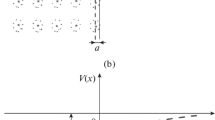Abstract
For the first time to our knowledge, the Kane’s (k, p)-theory describing the electron mass renormalization in bulk semiconductors, is modified for thin (a few nanometers thick) quantum wires. It is shown that the longitudinal electron effective mass increases with quantum numbers of transverse motion. This leads to unique features of the electron spectrum in the wire under two conditions: (i) the band structure of a wire material is covariant, which makes impossible hole localization and (ii) the wire radius should be small enough. As a result, dispersion curves of electrons localized on wires intersect, and the associated energy subbands cross. Therefore, a longitudinal electric pulse easily creates population inversion. This can be a theoretical basis for the new principle of operation of quantum amplifiers and generators.


Similar content being viewed by others
Notes
Here we do not consider the effects of the “intrinsic anisotropy” of the effective mass, associated with the difference between principal values of effective mass tensors in bulk semiconductors. It is clear that this will only amplify awkwardness and mask the essence of the phenomenon under study.
It can be slightly corrected by the Coulomb interaction of localized electrons, since holes cannot be localized at the wire; therefore, the excess negative charge of the wire is not compensated. For the system of quantum dots, this leads to the constraint on the probability of populating vacant levels [9].
REFERENCES
I. Vurgaftman, J. R. Meyer, and L. R. Ram-Mohan, “Band Parameters for III—V Compound Semiconductors and their Alloys,” J. Appl. Phys. 89, 5815 (2001). https://doi.org/10.1063/1.1368156
A. M. Mandel, V. B. Oshurko, S. G. Veselko, K. G. Solomakho, and A. A. Sharts, “Influence of the Form of Small Quantum Dots on the g-Factor and on the Effective Mass of Bound One-Electron State,” Ing. Phys. No. 9, 3 (2018). https://doi.org/10.25791/in?zik.09.2018.172
A. Y. Shick, L. G. Bakueva, S. P. Musikhin, and S. A. Rykov, Physics of Low-Dimensional Systems (Nauka, St. Petersburg, 2001).
V. Ya. Demikhovsky and G. A. Vugalter, Physics of Quantum Low-Dimensional Structures (Logos, Moscow, 2000).
E. O. Kane, “Band Structure of Indium Antimonide,” J. Phys. Chem. Solids 1, 249 (1957).
L. M. Roth, B. Lax, and S. Zwerling, “Theory of Optical Magneto-Absorption Effects in Semiconductors,” Phys. Rev. 114, 90 (1959).
A. I. Anselm, Introduction to the Theory of Semiconductors (Nauka, Moscow, 1978).
A. M. Mandel, V. B. Oshurko, S. G. Veselko, K. G. Solomakho, S. M. Pershin, and A. A. Sharts, “g-Factor Calculation in Small Quantum Dots,” Bull. Lebedev Phys. Inst. 45, 282 (2018). https://doi.org/10.3103/S1068335618090063
A. M. Mandel, V. B. Oshurko, and S. M. Pershin, “System of Ideal Quantum Dots with Coulomb Interaction,” Quantum Electron. 49, 505 (2019). https://doi.org/10.1070/QEL16823
Funding
This work was supported by the Russian Foundation for Basic Research, project no. 20-07-00983A and the Ministry of Higher Education and Science of the Russian Federation, project no. FSFS-2020-0025.
Author information
Authors and Affiliations
Corresponding author
Additional information
Translated by A. Kazantsev
About this article
Cite this article
Mandel’, A.M., Oshurko, V.B., Pershin, S.M. et al. EFFECT OF SIZE QUANTIZATION SUBBAND CROSSING IN THIN QUANTUM WIRES. Bull. Lebedev Phys. Inst. 47, 296–299 (2020). https://doi.org/10.3103/S1068335620100073
Received:
Revised:
Accepted:
Published:
Issue Date:
DOI: https://doi.org/10.3103/S1068335620100073



